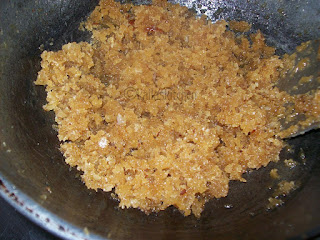Hope all who celebrated Vinayaka Chathurthi have feasted on an array of sweet and savory dishes, yesterday. Both my mother and mother-in-law makes only the sweet and salt varieties of kozhukkattais as prasadam for Chathurthi. I too follow the same tradition. Though I make it every year, somehow the recipes have not made it to the blog. This time, I was determined to take pictures and post it here. Most of the time, too much of work drains me off and I will be in no mood to click pictures. This time, it happened that things started on a slow note right from the morning. So, I thought to myself that I better not hurry up and let the day takes it course. I felt 'Slow and Steady Wins the Race' will hold good for the situation. Those thoughts put me at ease and I clicked some pictures too.
I prepared the outer covering for both the kozhakkattais together. I took 3 cups of rice flour. I will give the recipe as I made.
Sweet Kozhukkattai/Modak
Yields - 30-35 nos
For the outer covering
- Rice flour - 3 cups
- Water - 6 cups
- Milk - 1 tblspn
- Coconut oil/Ghee - 2 tspn (I added coconut oil)
- Salt - 1/2 tspn
For sweet filling
- Grated jaggery - 1 cup
- Fresh grated coconut - 2 cups
- Ghee - 2 tspn
- Cardamom/Elaichi powder - 1/4 tspn
Method
Take a kadai big enough to hold 6 cups of water. Add water, milk and oil/ghee. When water starts boiling, slowly add the measured rice flour. Keep stirring so that no lumps are formed. When the dough comes together, remove from the heat. This will take only 5 minutes. Close the dough with a plate.
While the dough for the outer cover cools, we can prepare the sweet filling. Take the jaggery with 1/4 cup of water in a kadai. Let the jaggery melt and the syrup starts boiling. The syrup need not be very thick. It should be sticky and close to the one string consistency. Add the grated coconut, elaichi powder and ghee. Stir well and continue to cook till the liquid dries up and coconut mix is moist. Switch off the heat.
Leave it to cool. Divide the filling into small balls.
Take a ball of the dough. Knead it well. Use ghee/oil to apply on your hands. Take a gooseberry sized dough. Flatten it using your fingers. Make it thin. Place a coconut-jaggery ball on the center. Gather the edges and seal it and form a pointed top. Repeat it till you use up all the fillings.
Keep the prepared modaks in the steamer and steam cook for 10-12 minutes or till the modaks have a shiny appearance.
Let it cool on the steamer for few minutes before you take it out on a plate. When you try to remove while hot, it may break. If you are placing the modaks on a banana leaf then it will be easy since you can pull out the leaf along with the whole lot.
Uzhunthu Kozhakkattai
Yields- 25-30 nos
For the filling
- Urad dal - 3/4 cup
- Grated coconut - 1/4 cup
- Green chillies - 4 nos
- Salt to taste
- Hing powder - 1/4 tspn
To temper
- Oil - 1 tblspn
- Mustard seeds - 1 tspn
- Red chillies - 2 nos
- Urad dal - 1 tspn
- Curry leaves - 1 stalk
Method
Soak the urad dal for 45 minutes. Drain and leave it on the colander for few minutes so that all the water is drained out fully. Take the green chillies and salt in the mixer grinder. Pulse it. Then add the drained urad dal and grind it coarsely.
Take the ground mixture in a bowl and steam cook it for 10 minutes. Cool it. Crumble the steamed mixture. Heat oil in a kadai. When hot, add mustard seeds and let it splutter. Add red chillies, urad dal and curry leaves. When the dal starts to brown, add the steamed and crumbled urad dal, coconut and hing. Mix well and cook for 2-3 minutes and remove from the heat.
The shape of uzhunthu kozhakkattai is different. Its shaped oblong and the keep a tablespoon of filling from end to end. Horizontally, bring the edges and stick it. You can press down the edges to seal it firm. Steam cook for 10-15 minutes.
If you have some leftover urad dal filling, mix it with cooked rice and Uzhunthu sadam is ready.








































